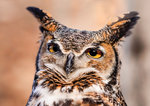Cloudy, 53° F
With winter hours still in effect at his new job, Nathan Doerr probably could’ve taken the day off. Still settling in and expecting a furniture delivery, there was plenty to do to make Park …
This item is available in full to subscribers.
The Powell Tribune has expanded its online content. To continue reading, you will need to either log in to your subscriber account, or purchase a subscription.
If you are a current print subscriber, you can set up a free web account by clicking here.
If you already have a web account, but need to reset it, you can do so by clicking here.
If you would like to purchase a subscription click here.
Please log in to continue |
|


With winter hours still in effect at his new job, Nathan Doerr probably could’ve taken the day off. Still settling in and expecting a furniture delivery, there was plenty to do to make Park County his home. But Tuesday is the day he walks the owl.
Doerr is the new curator at the Draper Natural History Museum — the second in the history of the facility inside the Buffalo Bill Center of the West. He replaced Charles Preston, designer and developer of the museum.
Among Doerr’s many responsibilities is overseeing the Raptor Experience and participating in golden eagle research, now in its 12th year. On Tuesdays he comes in to get his own experience with the raptors — a type of cross-training.
“In the event of an emergency, I want to be able to properly help out,” Doerr said.
There’s obviously much to do as curator. Cross training with Melissa Hill, assistant curator of the raptor program, was optional, but a task he takes seriously. The training started with Teasdale, the museum’s 10-year-old great horned owl that was the Experience’s first raptor.
There’s a lot to learn. You don’t just take an owl for a walk without knowing all the one-handed knots and proper care. Doerr was more cautious than nervous taking control of the 3-pound bird.
“He’s is definitely the most patient,” Hill said, talking about Teasdale.
Walking through the halls of the vacant museum, both curator and bird seemed to get more comfortable as the session moved along. Doerr will continue to meet the rest of the 11 birds in the program, working his way up to Kateri, a golden eagle, if he continues the training for years. There’s much to learn before then — Kateri is a lot of bird on your arm.
Growing up, Doerr was a science junkie. He didn’t play sports or hang out at the mall; instead, he began volunteering at the historic Sheridan Inn at the age of 14.
“I had no life in high school because I was [at the inn] every day after school,” he said. “Every weekend, even after I went to college when I came home for holiday breaks, I was [there].”
He earned a bachelor’s in environmental studies — with a focus on science and a concentration in biology — from Carroll College in Helena, Montana, and a master’s degree in non-formal education from Prescott College in Arizona. When Doerr returned to Wyoming, he headed back to the Sheridan Inn, his home away from home.
While he feels “terrible” that he didn’t spend more time with family on his breaks, the inn “was fundamental in getting me to where I am today,” he said.
He eventually became the executive director at the Sheridan County museum and went on to serve as the curator of education at the Wyoming State Museum in Cheyenne
Rebecca West, director of the curatorial education and museum services division at the Center of the West, said she was excited to be able to lure Doerr away.
“He’s very intellectual, but he’s also an excellent business person — a whiz with a budget,” West said. “And he’s got an amazing balance between the creativity in the sciences.”
“What we needed was somebody who can take all that great [research] information and make it shareable for outreach,” she added. “And that’s where his best talent lies.”
Doerr is intent on continuing research and interpretive work at the Draper.
“Imagine you walk into a museum and the museum doesn’t have any interpretation. There are no labels. It’s just full of objects or artifacts. It can be an amazing experience, but it can also be a difficult experience. It puts a lot of pressure on you to try and figure out what that museum is portraying — what that museum is trying to tell you,” he said at a recent Lunchtime Expedition program at the center. “So that tells us just how important the interpretive value of museums can be.”
While not a research scientist, like Preston, Doerr is intent on diversifying research projects. He’d like to add a botany project that would work in conjunction with the museum’s herbarium. And he’d like to involve citizen scientists in projects.
But Doerr is still just adjusting to the steep learning curve of the position. And he’s pinching himself, hoping not to wake up and find his fortune is all a dream.
“The Center of the West was always a dream,” he said. “I thought the Draper would be an amazing place — the curator position here — but I never thought it would happen. So it’s a dream come true.”
For many years he has tried to live his life by some advice from Margaret Murie, often referred to as the “grandmother of the conservation movement.” Murie often advised that, “You are only half a person if you do not care.”
“That is a mission that has stuck with me every day and will continue to stick with me,” Doerr said. “It’s something that I think every time it comes to make a career decision, or a programmatic decision.”